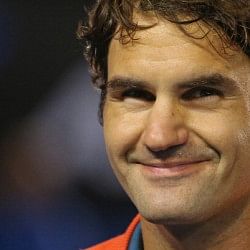
Roger Federer: Fall and rise of a timeless champion

Roger Federer of Switzerland smiles as he celebrates victory in his fourth round match against Jo-Wilfried Tsonga of France during day eight of the 2014 Australian Open at Melbourne Park on January 20, 2014 in Melbourne, Australia.
Everybody who has watched tennis knows who Roger Federer is. Such was his domination of the sport that his name became synonymous with exemplary tennis. He ruled all but the clay courts during his prime. He played with such elegance and finesse that it felt like an exquisite ballet performance. Roger Federer had an effortlessly smooth and graceful game which helped him maintain an exceptionally high level of consistency. There was no stopping this Swiss maestro until suddenly he started showing signs of slowing down in 2010. In 2011 Roger Federer didn’t win a single major event.
The likes of Rafael Nadal and Novak Djokovic started believing that they can beat Federer on hard courts as well as grass and they went on to win all the important matches. But a resilient Federer hit back with a stunning performance in 2012 Wimbledon to add to his phenomenal record, an astonishing 17 majors trophies. He also regained world number one status during that sunny spell. But time had other plans. 2013 was a miserable year for him after he didn’t reach any majors final and started losing to players like 116 ranked Sergiy Stakhovsky. A desperate Federer tried a bigger racquet which only made things worse.
The sporting world started to write off the 32-year-old veteran. His movement was too slow, and his forehands too weak but one man believed in turning things around and it was none other than Roger himself. He wasted no time in going back to the drawing board and analyzing the situation. He decided to seek the help of champion of yesteryears, the serve and volley expert Stefan Edberg.
After winning his first 3 rounds without breaking a sweat at the Australian Open, the real test of Federer’s physical and mental game came in the form of the aggressive adversary Jo Wilfried Tsonga. Their epic 5 setter from 2013 is still fresh in every tennis fans’ memory. But Roger Federer delivered yet again by defeating the French man in straight sets. His new racket with a much bigger head is generating more power and also has given him more margins for error. His unforced error column is looking much prettier than what it used to be the year before.
Being in the group of death meant his quarterfinal opponent will be Britain’s number one Andy Murray. Pundits forecasted it to be a cracking contest but surprisingly it was rather one sided. Roger Federer’s forehand and his movement was a merry to watch. He carved through the court to hit winners after winners in an excellent display of pure class which left the Brit admonishing himself. But the truth is there was little Murray could have done to stop the Fedex. It was Federer’s day and he had no plans of bowing out.
Andy Murray fought valiantly and got the 3rd set only to lose the match in a tight 4th set. The big question everyone is asking is what has Stefan Edberg brought to the table to make such a big change of fortune for Federer? Some say its his backhand while some others are of the opinion that his volleying skills are what’s making the difference. Maybe Edberg just reminded Roger Federer how great a player he is and what he is capable of achieving? Whatever it might be, it’s working. Tennis got back the Federer of his glory days, enjoy it while it lasts.